Realtime coverage of Soyuz TMA-18 entry and landing
1:35 a.m. EDT, 09/25 Update: Soyuz TMA-18 lands in Kazakhstan (2:05 a.m. update: adding photos; crew description)
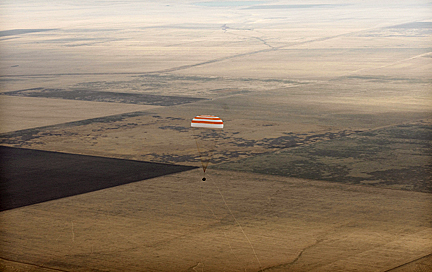 The Soyuz TMA-18 spacecraft, moments before landing.
The Soyuz TMA-18 spacecraft, moments before landing.
(Photo: NASA/Bill Ingalls)Running one day late, a Russian Soyuz capsule carried two Russian cosmonauts and a NASA astronaut back to Earth early Saturday, the final chapter in an action-packed six-month mission aboard the International Space Station.
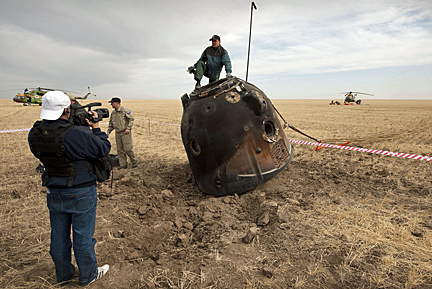 The charred descent module, awaiting crew extraction.
The charred descent module, awaiting crew extraction.
(Photo: NASA/Bill Ingalls)Dropping through a clear sky under a huge orange-and-white parachute, the charred Soyuz descent module landed upright and on target near the town of Arkalyk at 1:23 a.m. EDT (11:23 a.m. local time).
"And the search and recovery forces now report the Soyuz TMA-18 has landed," said Rob Navias, mission control commentator at the Johnson Space Center in Houston.
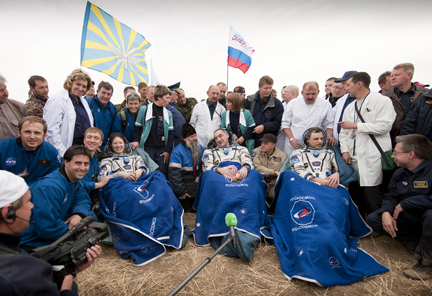 Tracy Caldwell Dyson, left, Soyuz commander Alexander Skvortsov,
Tracy Caldwell Dyson, left, Soyuz commander Alexander Skvortsov,
center, and flight engineer Mikhail Kornienko, right, relax after
landing. (Photo: NASA/Bill Ingalls "The soft landing engines reported to have worked perfectly. Alexander Skvortsov, Tracy Caldwell Dyson and Mikhail Kornienko, back on Earth after 176 days in space."
Russian recovery forces, including NASA flight surgeons and support personnel, rushed to the landing site from nearby staging areas to assist Skvortsov, Kornienko and Caldwell Dyson as they began the process of re-adapting to Earth's gravity after 176 days in space.
But all three appeared relaxed and in good spirits after they were assisted from the spacecraft, enjoying fresh fruit and chatting with recovery personnel.
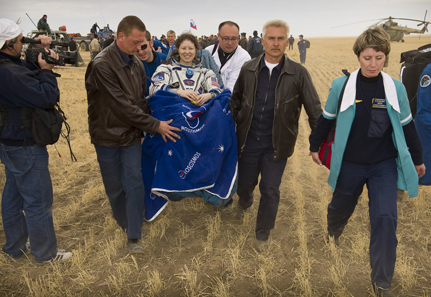 Tracy Caldwell Dyson is carried to a nearby tent for a post-landing
Tracy Caldwell Dyson is carried to a nearby tent for a post-landing
medical check. (Photo: NASA/Bill Ingalls) After initial medical exams, all three crew members were to be flown to Karaganda for a traditional Kazakh welcome. Skvortsov and Kornienko then planned to head for Star City near Moscow while Caldwell Dyson was scheduled to fly back to the Johnson Space Center in Houston aboard a NASA jet.
Strapped into the Soyuz TMA-18 spacecraft, the same vehicle that carried them into orbit April 2, Skvortsov, Kornienko and Caldwell Dyson undocked from the space station's upper Poisk module at 10:02 p.m. Friday.
An attempt to undock Thursday night was blocked by problems with a sensor in the docking mechanism holding the Soyuz to the Poisk docking port. After extensive troubleshooting, station flight engineer Fyodor Yurchikhin installed jumper cables that emulated the expected signals from a bypassed "hatch locked" sensor, restoring the docking system to operation.
There were no problems during the second undocking exercise Friday and after moving the Soyuz a safe distance away, Skvortsov fired the ship's braking rockets for four minutes and 21 seconds starting at 12:31:17 a.m. Saturday. That slowed the craft by about 258 mph and put it on course toward the targeted landing site.
After a half-hour free fall, the Soyuz TMA-18 descent module fell into the discernible atmosphere at an altitude of about 63 miles at 12:59 a.m. Parachute deployment was normal, and the capsule touched down without incident.
The most dramatic moments of the crew's six months in space came at the end of July when one of the space station's two coolant loops shut down because of an ammonia pump failure.
Forced to power down numerous space station systems to prevent overheating, the station crew quickly geared up for a complex three-spacewalk repair job by Caldwell Dyson and Douglas Wheelock.
"What would historians write about this increment? Well, certainly the headline would be the pump module remove and replacement, the day the ammonia stopped flowing in loop A and the three dramatic spacewalks and all of the work that was involved to change those out in the limited amount of time we felt we had," Caldwell Dyson said before undocking.
"I think historians could write a whole lot about that, everything from the problem itself to how this space station is so robust that it can withstand a failure like that.
After the successful spacewalks, Caldwell Dyson told CBS News the experience was "awe inspiring."
"You know, for the last four or five months I've been looking out our cupola window at the sunrises and sunsets and been brought to tears by the multitude of stars once the sun goes down," she said. "And I wondered just how I would feel when I went out there.
"For me, my first EVA was a culmination of 12 years of training and being here and watching and learning and having a huge desire to do that. And so the feeling I was having out there, being on structure, outside the space station, was as emotional as you can get in an EMU (spacesuit), looking out at the sunrise for the first time. It was, like I said, a culmination of so much desire and years of training, it was a feeling I'll never forget."
In an interview last week with ABC News, she said she would miss her two crewmates "because as soon as we land ... I get on a plane and I come right back to Houston and my two Russian crewmates, who I spent all my time with, I won't be able to see for a couple of weeks.
"I'm definitely going to miss the views," she added. "I don't think there's a time I could enter the cupola with the intent of staring at the views and not get a little choked up thinking this might be the last time. But then I'm also encouraged by the fact that not too many people get to see that view and I try to take it in (so) I can help describe it to folks when I come back and help them feel a little bit of it.
"The one thing I'm not going to miss is the lack of longevity in my toothbrush. I'm really looking forward to having running water," she laughed.
The departure of Soyuz TMA-18 left the International Space Station with a crew of three: Expedition 25 commander Wheelock, Yurchikhin and Shannon Walker.
They will have the station to themselves for the next two weeks before the arrival of three fresh crew members aboard an upgraded Soyuz TMA-01M spacecraft scheduled for launch Oct. 7.
12:35 a.m. EDT, 09/25 Update: Soyuz braking rockets firedDropping out of orbit, the Soyuz TMA-18 spacecraft fired its braking rockets for four minutes and 21 seconds early Saturday, putting the ship on course for a landing in central Kazakhstan.
With commander Alexander Skvortsov at the controls, flanked by flight engineer Mikhail Kornienko and Tracy Caldwell Dyson, the de-orbit rocket firing began on time at 12:31:17 a.m. EDT, slowing the ship by about 258 mph.
After a half-hour free fall, the three modules making up the Soyuz spacecraft will separate and the central descent module carrying the crew will hit the discernible atmosphere at an altitude of about 63 miles at 12:59 a.m.
If all goes well, the spacecraft will touch down near the town of Arkalyk in central Kazakhstan around 1:21:53 a.m. EDT (11:21:53 a.m. local time).
This status report will be updated after landing or as conditions warrant.
10:15 p.m. EDT, 09/24 Update: Soyuz undocks from space station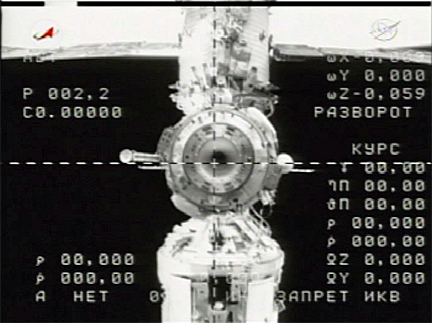 The view of the space station from the Soyuz TMA-18 spacecraft
The view of the space station from the Soyuz TMA-18 spacecraft
moments after undocking. (Photo: NASA TV) Running a day late because of docking system problems, a Russian Soyuz spacecraft carrying two cosmonauts and a NASA astronaut undocked from the International Space Station late Friday, kicking off a three-and-a-half-hour descent to Earth to close out a six-month stay in space.
With outgoing Expedition 24 commander Alexander Skvortsov at the controls in the Soyuz's center seat, the TMA-18 vehicle departed the Poisk module docking port at 10:02 p.m. EDT as the two spacecraft passed 220 miles above the Russia-Mongolia border. Strapped into a seat to Skvortsov's left was flight engineer Mikhail Kornienko. To his right was Tracy Caldwell Dyson.
Unlike the crew's first attempt to head home Thursday night when trouble with hatch sensors forced a 24-hour delay, there were no problems of any significance Friday and the hatch, hot-wired to bypass a sensor problem, worked flawlessly.
"We have separation," someone radioed as the Soyuz backed away.
"Thank you, Fyodor, thank you to the entire crew," Skvortsov radioed Fyodor Yurchikhin and his two Expedition 25 crewmates, commander Douglas Wheelock and Shannon Walker.
 The Soyuz TMA-18 spacecraft, moments before landing.
The Soyuz TMA-18 spacecraft, moments before landing. The charred descent module, awaiting crew extraction.
The charred descent module, awaiting crew extraction. Tracy Caldwell Dyson, left, Soyuz commander Alexander Skvortsov,
Tracy Caldwell Dyson, left, Soyuz commander Alexander Skvortsov, Tracy Caldwell Dyson is carried to a nearby tent for a post-landing
Tracy Caldwell Dyson is carried to a nearby tent for a post-landing The view of the space station from the Soyuz TMA-18 spacecraft
The view of the space station from the Soyuz TMA-18 spacecraft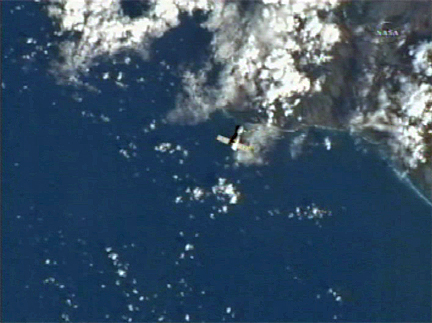 The Soyuz TMA-18 spacecraft passing above the Hawaiian islands.
The Soyuz TMA-18 spacecraft passing above the Hawaiian islands. 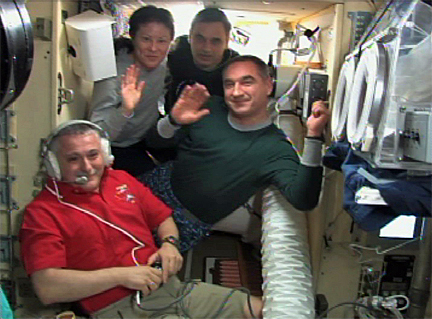 Departing Expedition 24 crew members Tracy Caldwell Dyson,
Departing Expedition 24 crew members Tracy Caldwell Dyson,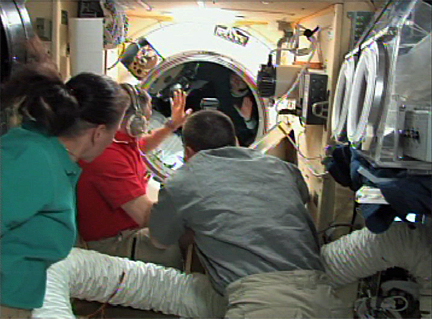 Departing Expedition 24 commander Alexander Skvortsov waves
Departing Expedition 24 commander Alexander Skvortsov waves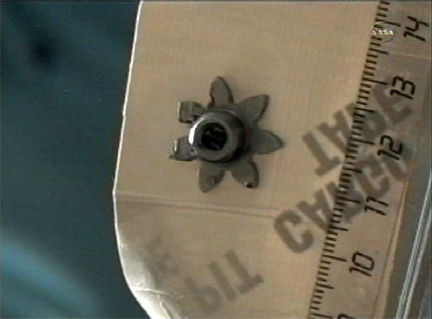 Cosmonaut Fyodor Yurchikhin shows a small, apparently damaged
Cosmonaut Fyodor Yurchikhin shows a small, apparently damaged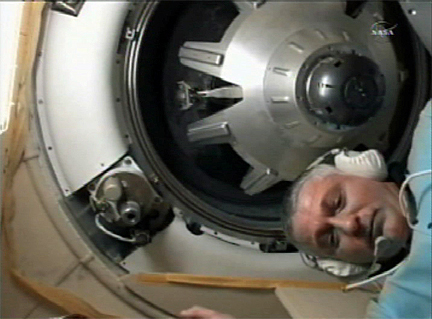 Yurchikhin shows the docking system interface beside the main hatch
Yurchikhin shows the docking system interface beside the main hatch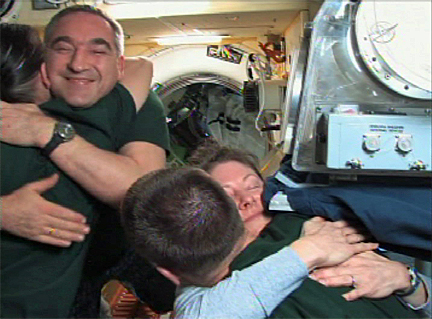 Cosmonaut Alexander Skvortsov embraces Shannon Walker, left, while
Cosmonaut Alexander Skvortsov embraces Shannon Walker, left, while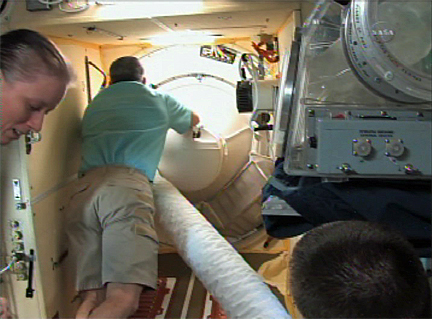 Cosmonaut Fyodor Yurchikhin inspects the hatch in the Poisk module
Cosmonaut Fyodor Yurchikhin inspects the hatch in the Poisk module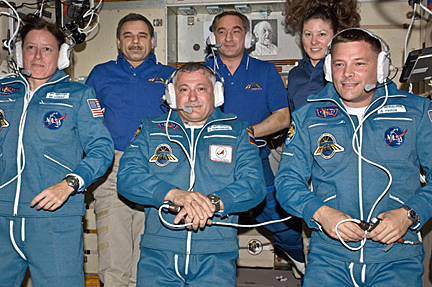 Returning Expedition 24 crew (back row, left to right): Mikhail Kornienko,
Returning Expedition 24 crew (back row, left to right): Mikhail Kornienko,